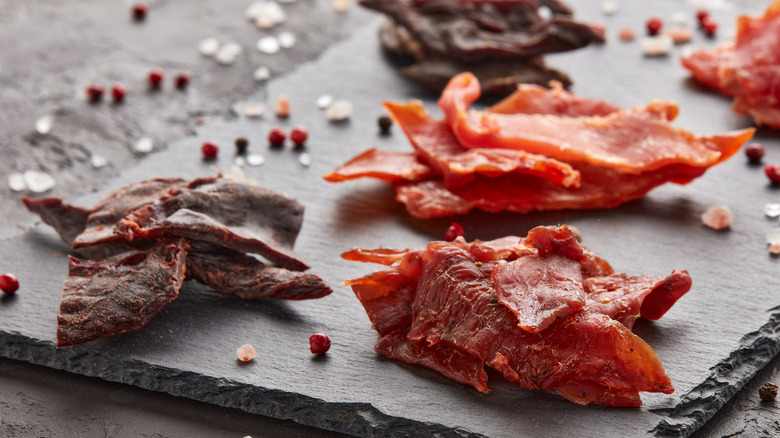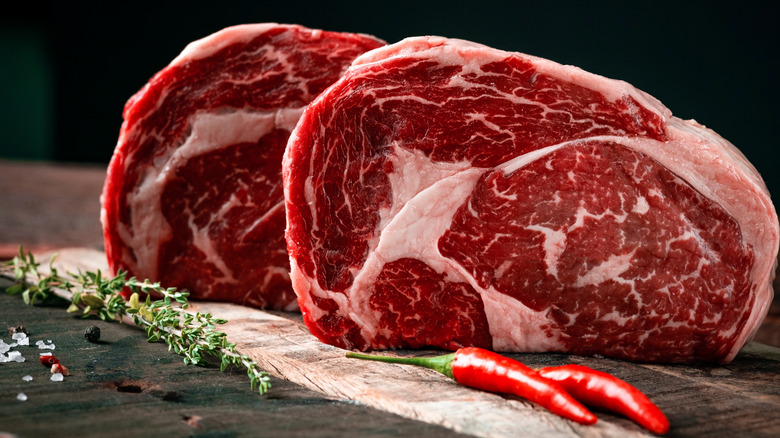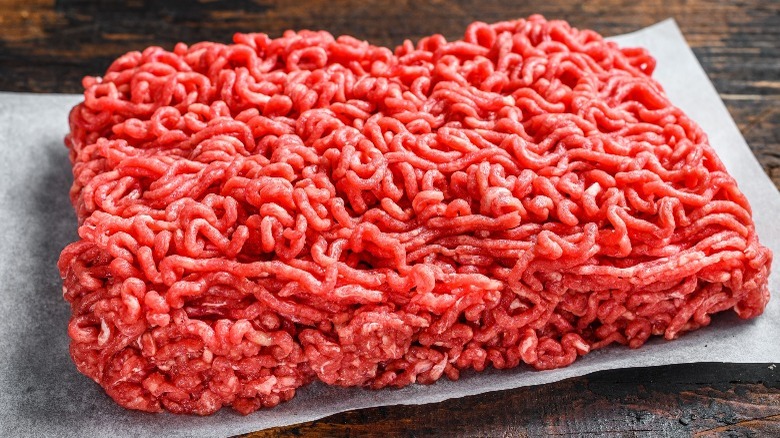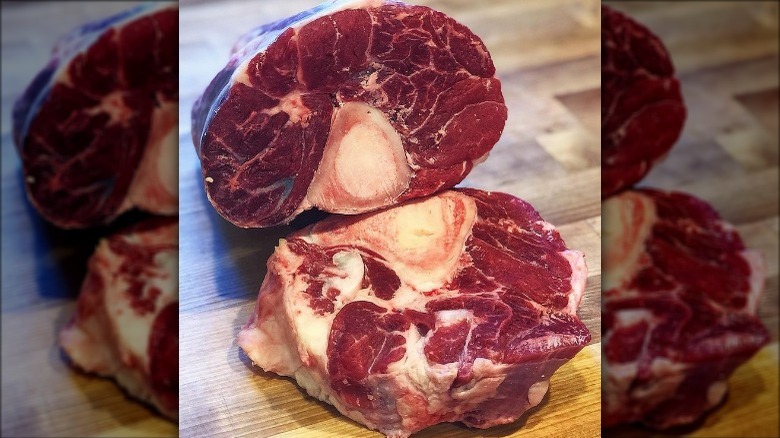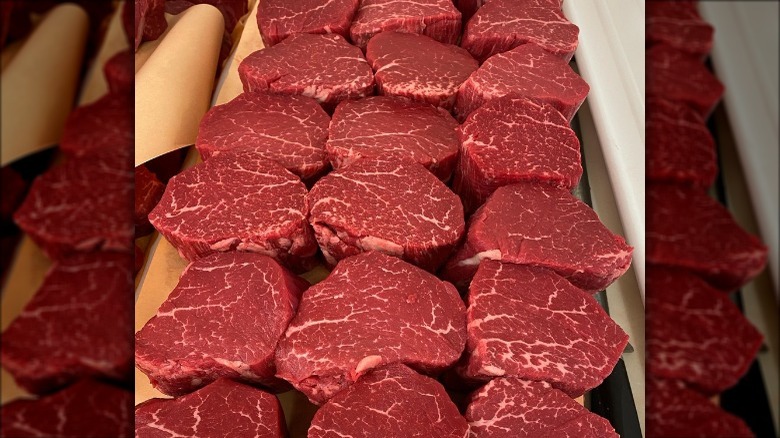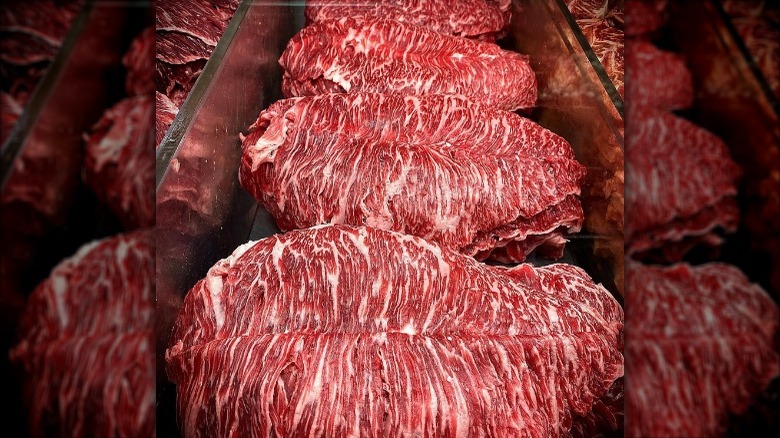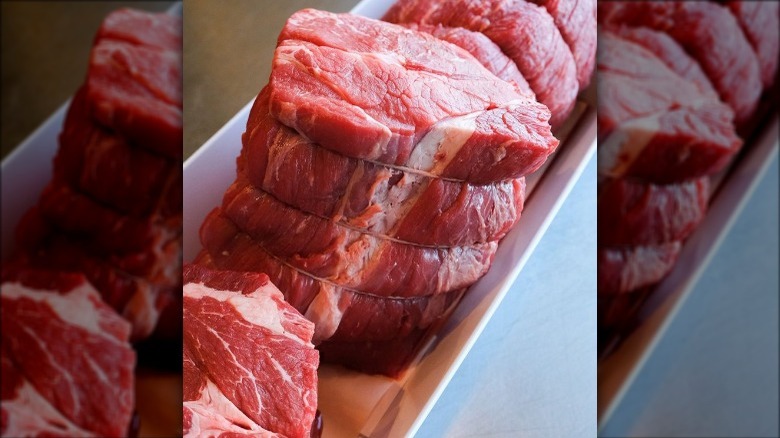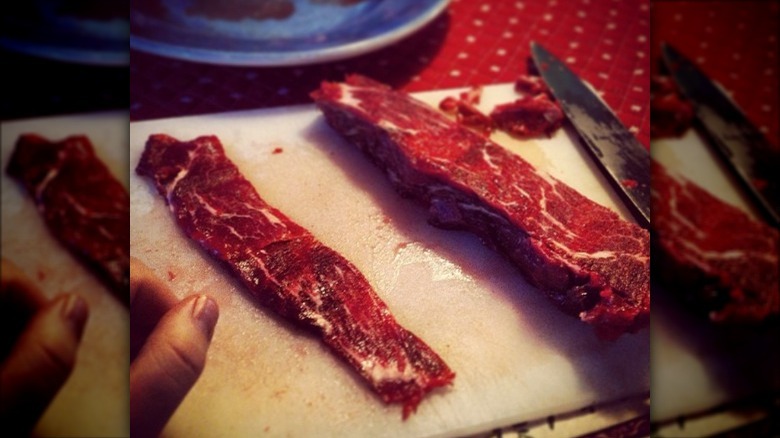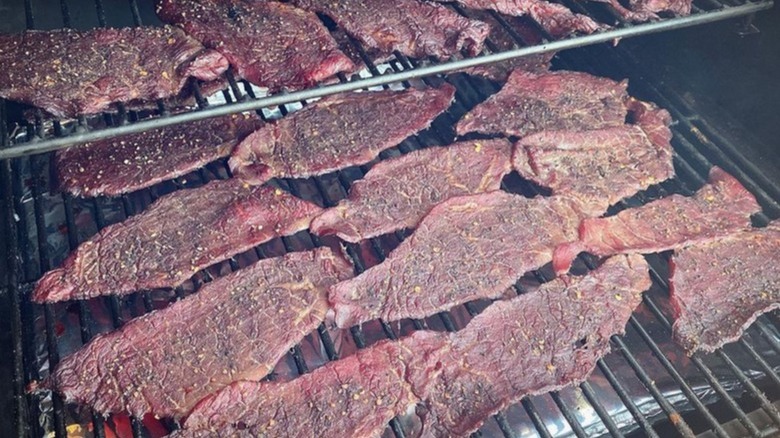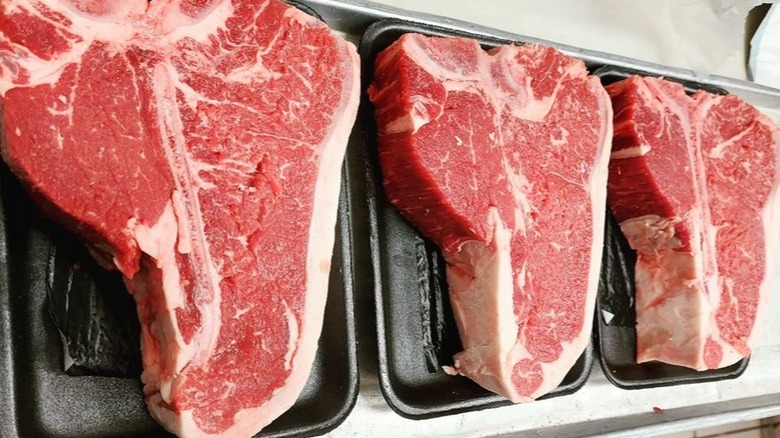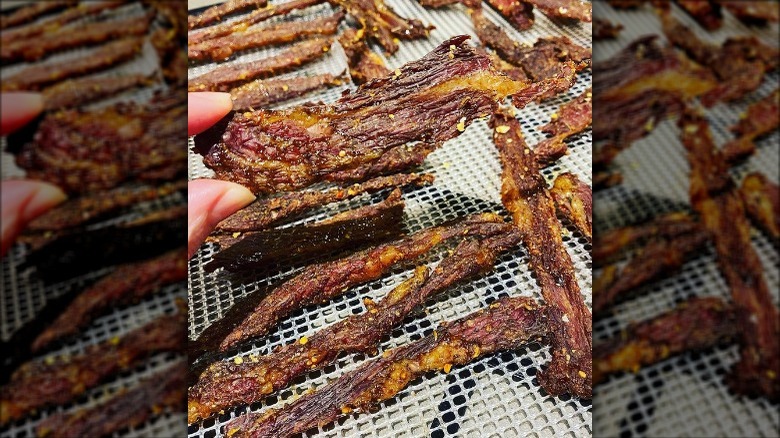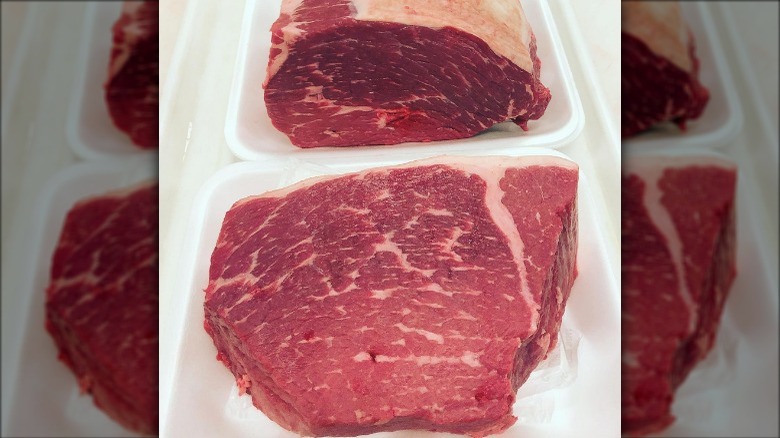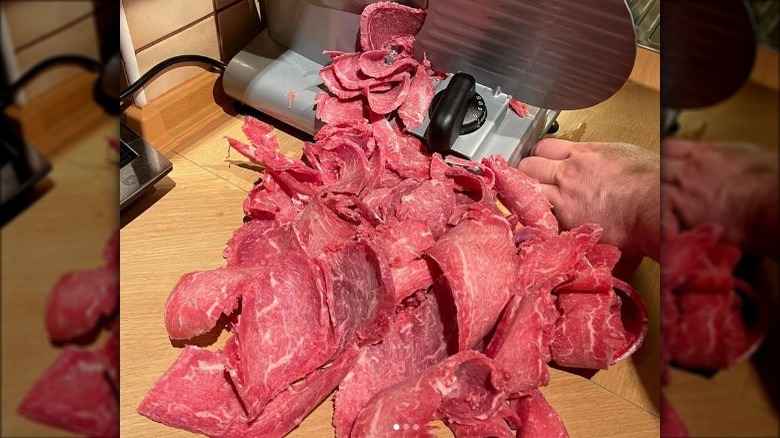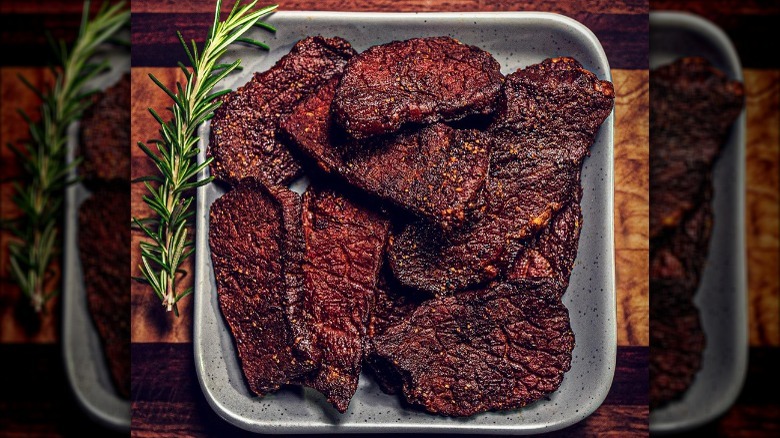Ranking Cuts Of Meat To Use For Beef Jerky Worst To Best
After deciding that you want to try your hand at making beef jerky, the first step you need to take is zeroing in on which cut of meat you'll use. While there are numerous cuts to pick from, a few cuts of meat stand out from the rest as the best choices to use for beef jerky. Conversely, there are certain cuts that should never be used.
With a history in the Americas dating back hundreds of years, beef jerky is most commonly made by heating beef just enough to kill any bacteria and then dehydrating the meat in order to remove the water so the bacteria don't regrow. Once the entire process is complete, this delicious snack can be stored inside of an airtight container for up to two months (via Jerkyholic).
By reading this ranking, you'll learn which cuts of meat are best for beef jerky and which cuts shouldn't be used under any circumstances.
13. Rib
If your overall favorite cut of meat is rib, you have a ton of company. Ribeye is widely regarded as the ultimate cut of steak and smoking beef ribs almost always results in a glorious meal. However, when it comes to beef jerky, the rib cut should be completely avoided. If you ignore this advice, you'll be wasting time, money, and a cut of meat that would have been better served in practically any other recipe under the sun.
The first issue with using the rib cut is that it's difficult to slice into strips of meat that would work for beef jerky. That's because rib meat is fine-grained and doesn't hold together well if cut into small strips. Secondly, and most importantly, this meat will almost completely disintegrate during the dehydration process. Unless you want your beef jerky to be tiny pieces of meat shards, pick a cut that is higher in this ranking.
12. Ground beef
While it's certainly possible to make beef jerky from ground beef, it's simply not an idea you should act upon. There are many cuts of meat that are far superior. Not only will the resulting beef jerky not look like traditional beef jerky, but it can also be risky health-wise due to the fact that packaged ground beef that you buy at your local grocery store can include meat from hundreds of different sources. Rolling the dice and taking that sort of gamble just isn't worth it. Even if ground beef is the cheapest meat you can find, spend a few more dollars to get a cut of meat that is more appropriate.
Yes, ground beef can be used to make many things beyond the traditional burgers and meatloaf. That said, don't get too adventurous and think this is the cut of meat that you should use for beef jerky.
11. Shank
While the shank cut of meat comes from the part of the cow that's near the round, flank, and brisket sections, it's much tougher than those desirable cuts. Unless you're a masochist with a strong set of chompers and hours of time to waste, don't even think about using this cut of meat to make beef jerky.
Why is shank meat such a substandard choice? It's because this cut is by nature super chewy, really dry, and unyieldingly fibrous. If you try to make beef jerky out of shank meat, you'll end up with something that will be so tough that it'd be difficult to eat. In fact, you could probably chew and swallow your favorite leather shoe faster than you can chew and swallow beef jerky made from shank meat. Save yourself the aggravation (and a trip to the dentist) and just say no. Save the shank for slow-cooking instead.
10. Tenderloin
The reason why tenderloin isn't higher on this list is hiding in plain sight in the name of this cut of meat. Even if you like your beef jerky on the soft side of the chewiness spectrum, everyone should agree that there's a limit to the tenderness that is acceptable. Beef jerky made from tenderloin is so tender that it's unappetizing. A soft steak made from tenderloin like filet mignon can be breathtakingly amazing. However, beef jerky that's so soft that it practically melts in your mouth is as gross as it sounds.
Tenderloin is also expensive, perhaps the most expensive of all the meat you'll see at a supermarket. That is another reason why this cut of meat is near the bottom of our ranking. If you're going to shell out top dollar to make beef jerky, do your research and buy meat that is more capable of doing the job right.
9. Skirt
If you're out on the town and you eat skirt steak, it's easy to fall in love. When it's prepared correctly, this is a fantastic cut of meat. For example, this is the type of meat that's commonly used to create masterpieces such as the carne asada and fajitas found at your favorite Mexican restaurant. Its rich flavor can jazz up any dish and make you proud of your culinary skills.
But when it comes to beef jerky, skip the skirt. If you dehydrate this meat, it will become way too tough. Although it won't be as chewy as the aforementioned shank meat, it'll be close enough to give your jaw an unwanted workout. Moreover, this cut of meat will remain too fatty even after it has finished the dehydration process. You don't want your beef jerky to be free of fat but you should also avoid having large portions that are almost entirely comprised of fat.
8. Chuck
If you have an entire day to spare and want to spend it in your kitchen, making beef jerky from chuck is an okay idea. But if you're a normal human being in today's world of relentless hustle and bustle, that's not a good idea at all. While chuck is a great choice when you have a hankering for a juicy steak on a tight budget, it's not a great choice for beef jerky. The problem is its high fat content.
Before you can even think about making beef jerky from chuck, you'll spend hours upon hours trimming off the fat. Even after a lot of trimming, chuck will still have a higher than usual fat content. Considering that fat causes beef jerky to spoil prematurely, that's definitely problematic. If you spend the time making beef jerky, you'll want it to last a long time — or at least long enough for you to gobble it all up.
7. Sirloin
The first cut of meat on this ranking that you won't regret purchasing for beef jerky purposes is sirloin. Although it's not the best option, it's undoubtedly above average and can be used to make beef jerky that's so scrumptious that you'll want to brag to your friends about it. The best characteristic of sirloin is its strong, beefy flavor, which takes center stage if you use it to make beef jerky.
Two issues stop sirloin from rising into a top-five spot in this ranking. First, you'll need to trim off the fat. Thankfully, though, that process won't be nearly as time-consuming as it is with chuck. Second of all, sirloin comes with an elevated price tag. Truth be told, you can make beef jerky that tastes just as yummy without forking over an arm and a leg. Since other cheaper cuts make jerky that's just as tasty, there's no reason to shell out for sirloin.
6. Top round
For those carnivores who believe that Kirkland Signature Premium Extra Thick Steak Strips is the best brand of beef jerky and want to replicate that jerky at home, top round is the cut of meat you want to acquire. That beef jerky, which is sold at Costco and is known for being tender and oh-so juicy, is made exclusively with top round. You may also know this cut of meat as one of the common cuts used to make London broil.
Top round is known for being extremely lean, which means you won't have to spend any time trimming off fat. It's also relatively inexpensive, packed with an overflowing amount of flavor, and hearty enough to cut into thin slices, which are all perfect attributes when making beef jerky. The only thing to keep in mind is that the jerky will be tougher than average, so pick another cut if you're looking for a snack with a tender texture.
5. Short loin
You may think that you don't know about the short loin cut of meat but you do. This is the cut that is responsible for bringing NY strip steaks, Delmonico steaks, and porterhouse steaks to your dinner table. If you're making beef jerky, you could do a whole lot worse than picking up a package of short loin.
While its price tag may cause you to cringe, this cut of meat has a lot of characteristics that make it an outstanding choice for beef jerky. Firstly, it's tender but not so tender that it will fragment when it's dehydrated. Secondly, the amount of marbling in this meat is perfect because there's enough fat to keep the beef jerky flavorful but not so much that you'll spend valuable time trimming. Finally, you can cut short loin meat into small pieces without worrying about the pieces falling apart like when you try to thinly slice ribeye.
4. Brisket
Brisket is a cut of meat that tastes the best when you cook it for a long time. In fact, when you smoke brisket, you need to prepare to cook it for more than an hour per pound. Considering that some methods of making beef jerky involve a multiple-day process, going with a cut of meat like brisket that can withstand heat for hours on end makes a lot of sense.
Taste-wise, you'll adore beef jerky made from brisket. It will have a deep flavor that leaves your taste buds in a state of euphoria. Price-wise, you shouldn't have many complaints. If you look around, you'll be able to locate brisket that's available at a fair cost. Why isn't this cut in the top three? The only drawback is that brisket has a high amount of fat, which means you need to eat it quickly because it will spoil faster than other cuts.
3. Bottom round
If you want to make beef jerky with a rough and rugged texture, bottom round is the cut of meat you should select. Compared to the previously mentioned top round, this cut is quite a bit tougher but it's even more flavorful. And while it makes tough beef jerky, it's not so chewy that it will cause your jaw muscles to ache. Within a few chomps, it will soften up enough to allow you to enjoy the entire experience.
Bottom round is ultra-lean, which means that it will last a long time before spoiling. This cut, which you may know from it being used to make Swiss steak, is also extremely filling. Eat a few pieces of bottom round beef jerky and you'll feel full for a handful of hours. This cut of meat might not be the best of the best for beef jerky, but there are a lot of positive characteristics to be excited about.
2. Flank
For beef jerky with the richest, beefiest flavor, flank can't be topped. It has a strong aroma that you can smell from across the room. Once you get the jerky to your lips, you'll be stunned that it tastes even better. Flank beef jerky prepared to perfection also has the optimal amount of fat and a medium texture that will enthrall both those who prefer tender beef jerky and those who prefer tough beef jerky.
What keeps flank from the number one spot in our ranking is the fact that it will take time to master. First of all, you have to be sure to always cut it against the grain — and that's easier said than done. Second of all, the size of the pieces matters a bunch. If the pieces are too thick, the beef jerky will be too hard. If the pieces are too thin, the jerky will be too soft. It will take practice to learn to work with flank meat but it's unquestionably worth the effort to master.
1. Eye of round
When making homemade beef jerky, there's one cut of meat that ticks all the possible boxes: eye of round. Unlike flank, eye of round is forgiving enough that even someone new to the world of beef jerky can create a sensational and memorable snack on their first try. It's also inexpensive and lean, yet it explodes with bursts of flavor with each bite. Texture-wise, it's chewy at first but, seemingly by magic, it quickly becomes tender a few moments after entering your mouth.
While flank is worth trying out to see if you can master it, eye of round beef jerky is so stupendous that it can be what you return to over and over again without regret. Your wallet will love the selection and your taste buds will be beyond thrilled. At the end of the day, that winning combination is why eye of round richly deserves the top spot in this ranking.
